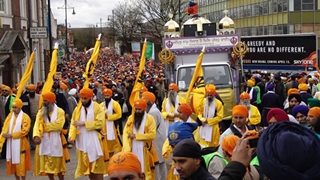
The traditional Sikh greeting meaning ‘the Khalsa belongs to God and all victory belongs to God’ is an apt way to start this overview on Vaisakhi: ‘Waheguru Ji Ka Khalsa, Waheguru Ji Ki Fateh’.
Sikhs around the world will celebrate Vaisakhi this year on 13-14 April and its significance lies in two key areas.
Firstly Vaisakhi (also pronounced ‘Baisakhi’) marks the spring harvest festival for many Indians and Sikhs across the Asian subcontinent. The cultural celebration of Vaisakhi as the dawn of a new harvest season is particularly prominent in Punjab (Northern India) which is commonly known as the ‘bread basket of Asia’; many farmers cultivate and harvest staple foods (such as flour and rice) from this region.
Within Sikhism, Vaisakhi commemorates the historic formation of the ‘Khalsa’ or ‘pure ones’ dating back to 1699 when the tenth Sikh Guru, Guru Gobind Singh Ji requested the Sikhs to congregate at Anandpur (a sacred city in Punjab known as the ‘city of bliss’) and requested five volunteers to give their lives for their faith.
One person came forward and was led inside a tent. The Guru returned to the congregation alone with only a bloody sword. Upon the fifth person entering the tent and the Guru returning with a bloody sword for the fifth time much to the amazement of the congregation, the Guru revealed all five men adorned in fine attire, unscathed and were subsequently initiated as the ‘Panj Pyare’ or ‘five beloved ones’ who were to become the first members of the ‘Khalsa’.
Each of the five beloved ones were members of various castes and social classes and by bringing them all together, the Guru had abolished caste, social hierarchy and class, demonstrating that equality was paramount for all humanity.
Upon their initiation into the Khalsa, the Panj Pyare were given the name of Singh, meaning lion for all males and females were to be called Kaur meaning princess – a reminder of their faith and the principles they were to follow as Sikhs (Sikh meaning ‘learner or disciple’).
The Khalsa or warrior community was now formed. To this day, many of you will come across many colleagues and people bearing the names Singh and Kaur reflecting their Sikh heritage and faith.
The Guru also prescribed the Five Ks which were to symbolise a baptised Sikh’s way of living through the following articles:
1. Kesh: uncut hair – not cutting one’s hair was a symbol that they accepted God’s will. The hair is often kept tidy through the tying of the turban.
2. Kangha: a wooden comb used to keep the hair tidy.
3. Kara: an iron or steel bracelet worn on the wrist. The wearing of the Kara always reminds Sikhs to consider their actions.
4. Kirpan: a sword or dagger used to defend the weak and oppressed. The kirpan is now a symbolic item for modern day Sikhs.
5. Kacchera: short breeches which also represent chastity.
Across the world on Vaisakhi, Sikh Gurdwaras (holy temples) will be decorated with many religious services taking place – many Sikhs and others of various faiths would traditionally attend the Gurdwara to mark the occasion.
Across the UK, Nagar Kirtan processions (neighbourhood singing of hymns) are traditionally held where people gather and escort the Sikh holy scripture, the ‘Guru Granth Sahib Ji’ through the streets led by five Sikhs dressed as the Panj Pyare.
The congregation follow the holy book on its journey, socialise and share in festive foods and collective prayer. In the UK, many Nagar Kirtans end at a mass gathering such as in London and the Midlands with attendees in excess of 100,000 gathering together.
I have many fond memories of joining the Nagar Kirtan as a youngster from my local Gurdwara and following the procession along the streets of the Black Country and ending up some miles later at our destination (usually a neighbouring Gurdwara), with plenty of food and drinks along the way offered by Sikh volunteers pitching their stalls on the pavements as we pass by.
Although my legs would be tired, I would be thrilled to spend a few hours walking with my friends and family through the cordoned-off streets to allow this important procession to take place. People would be singing hymns and the front of the procession would be teeming with Sikh martials arts expeditions, sword fighting and demonstrations of martial power on which the faith has been traditionally based.
Sikhs believe in one God who guides and protects them. They believe everyone is equal before God and that your actions are important to lead a good and honest life through the following principles:
• Honest earning with dignity and labour: to earn one’s livelihood through creative, productive and honest labour (Kirt Karna).
• To share the fruits of earnings with the needy: sharing with and caring for the needy and sick; helping those people who cannot help themselves (Wand Chhakna).
• Meditation on the Divine Name with love and devotion (Nam Japna).
Happy Vaisakhi to all Sikhs and non-Sikhs alike! Waheguru Ji Ka Khalsa, Waheguru Ji Ki Fateh
Download our Faith in Football calendar for the 2020-21 season.










